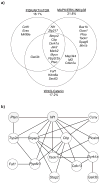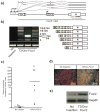Forward genetic screen for malignant peripheral nerve sheath tumor formation identifies new genes and pathways driving tumorigenesis
- PMID: 23685747
- PMCID: PMC3695033
- DOI: 10.1038/ng.2641
Forward genetic screen for malignant peripheral nerve sheath tumor formation identifies new genes and pathways driving tumorigenesis
Abstract
Malignant peripheral nerve sheath tumors (MPNSTs) are sarcomas of Schwann cell lineage origin that occur sporadically or in association with the inherited syndrome neurofibromatosis type 1. To identify genetic drivers of MPNST development, we used the Sleeping Beauty (SB) transposon-based somatic mutagenesis system in mice with somatic loss of transformation-related protein p53 (Trp53) function and/or overexpression of human epidermal growth factor receptor (EGFR). Common insertion site (CIS) analysis of 269 neurofibromas and 106 MPNSTs identified 695 and 87 sites with a statistically significant number of recurrent transposon insertions, respectively. Comparison to human data sets identified new and known driver genes for MPNST formation at these sites. Pairwise co-occurrence analysis of CIS-associated genes identified many cooperating mutations that are enriched in Wnt/β-catenin, PI3K-AKT-mTOR and growth factor receptor signaling pathways. Lastly, we identified several new proto-oncogenes, including Foxr2 (encoding forkhead box R2), which we functionally validated as a proto-oncogene involved in MPNST maintenance.
Conflict of interest statement
D.A. Largaespada has ownership interest (including patents) in Discovery Genomics, Inc. and NeoClone Biotechnologies International. He is also a consultant/Advisory Board member of Discovery Genomics, Inc. and NeoClone Biotechnologies International.
Figures







References
-
- Ducatman BS, Scheithauer BW, Piepgras DG, Reiman HM, Ilstrup DM. Malignant peripheral nerve sheath tumors. A clinicopathologic study of 120 cases. Cancer. 1986;57:2006–21. - PubMed
-
- Miller SJ, et al. Large-scale molecular comparison of human schwann cells to malignant peripheral nerve sheath tumor cell lines and tissues. Cancer Res. 2006;66:2584. - PubMed
Publication types
MeSH terms
Substances
Associated data
- Actions
- Actions
- Actions
Grants and funding
LinkOut - more resources
Full Text Sources
Other Literature Sources
Medical
Molecular Biology Databases
Research Materials
Miscellaneous

